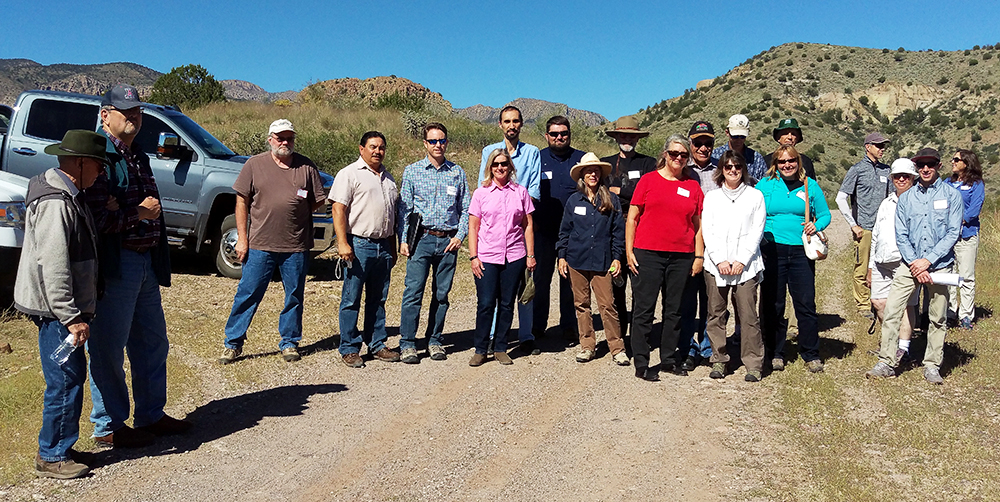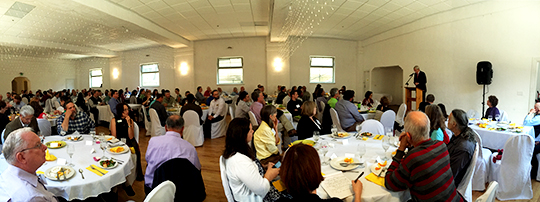COMMUNITY WATER & WATERSHED MANAGEMENT
2016 Annual New Mexico Water Conference (continued)
The next tour stop took participants across the valley to the west side of the Gila valley to view another proposed off-stream storage site at Winn Canyon. Continuing south, the group made its way to the existing diversion that supplies Bill Evans Lake where the tour ended. Much appreciation to Anthony Gutierrez for hosting the tour.

CAP Unit tour participants
Attorney Jeffrey Wechsler opened the conference with his talk, Where does all the water go in New Mexico? Jeff’s overview of New Mexico’s water setting was divided into the topic areas of: Where does the water come from? How is water used in New Mexico? Where does the water go? Presented was a review of compacts, adjudications, water development, and current litigation. His presentation set the tone for the conference topics and presenters addressing policy direction and opportunities; vegetation management and water yield; preserving agriculture against new demands; water resiliency; monitoring surface, groundwater, and vegetation relationships; groundwater recharge; and managing drought risks through water banks. Proceedings of the conference will be available and posted on the NM WRRI website.

2016 Albert E. Utton Memorial Water Lecture at the Murray Hotel
The 2016 Albert E. Utton Memorial Water Lecture by former Senator Jeff Bingaman was well received. His talk on Rethinking Western Water Management discussed three questions: What are our water policy objectives in the West? How well are our current laws and policies designed to achieve those objectives? How can we do better? Senator Bingaman also listed five objectives to pursue: ensure an adequate supply of water for current and future needs; ensure that our uses of water are sustainable; protect valid existing water rights; ensure our uses of water are consistent with protecting the environment; and facilitate the use of water for highest value purposes. The Senator said that if he identified the right objectives, he felt we can do a better job of aligning our laws, policies, and practices to achieve them. He provided six examples of alternative ways to administer and manage water to show how it can be done.
Planning for next year’s water conference will begin soon and is expected to include another information filled program with current topics, research, and inspiring discussion to formulate new horizons for the water resources citizenry to aim toward.
TR 371
Doing Hydrology Backwards in New Mexico to Estimate a Statewide Water Budget
Published Date:
March 2016
Authors:
Cameron Herrington and Ricardo González-Pinzón
Abstract:
Accurate statewide water budgets are dependent on the quality, quantity and availability of measured information in catchments. Given typical data acquisition constraints, water budgets rely on the measurement of a limited number of water fluxes (e.g., precipitation and streamflow) and on modeling tools that allow for estimation and scaling of other relevant, unmeasured fluxes. We seek to use a parsimonious modeling technique (Doing Hydrology Backward (DHB) from Kirchner (2009)) that utilizes discharge data alone to estimate catchment-averaged precipitation and evapotranspiration rates in New Mexico. Since the United States Geological Survey (USGS) now maintains a network of 23,000 stream gages nationally, with approximately 130 sites across the major catchments of New Mexico, estimating precipitation and evapotranspiration rates from streamflow data has enormous potential to provide catchment-scale information on processes that are not extensively monitored, but are key in estimating statewide water budgets. Ideally, the DHB method could take advantage of the highly scrutinized discharge datasets available from the USGS through the employment of a simple discharge-storage model to estimate catchment fluxes thus minimizing common modeling errors and bias caused by over-parameterization. We developed a MATLAB code capable of estimating catchment-average precipitation and evapotranspiration rates. We successfully validated the code using the original data presented by Kirchner (2009). Despite providing accurate estimates of hydrologic processes in humid catchments, the standard DHB model did not accurately represent precipitation rates observed in three dryland basins in New Mexico. As it is, the DHB code that we developed in MATLAB will be useful in humid catchments. However, it requires the addition and validation of snowmelt terms before it can be used in our characteristic New Mexico dryland basins.
Download:
Attachment: tr371.pdf
Keywords: Discharge, evapotranspiration, precipitation, water budget, dryland, climate change, equifinality, computer modeling, catchment, storage
